Abstract
Recycling swine wastewater is an environmental and economic issue for promoting the sustainable development of the pig industry worldwide. The application of a flocculant, non-ionic polyacrylamide (NPAM) for treating the contaminants in wastewater was trialed in this study. Firstly, the optimal pH value for the coagulation–flocculation of NPAM was adjusted by hydrochloric acid and sodium hydroxide. The viscosity of the flocculant solution was examined by a rotational viscometer and the morphology of the flocculant on the glass surface was examined by an optical microscope and an atomic force microscope. The result showed that a pH value of 11 or more was best for NPAM coagulation–flocculation. Subsequently, the swine wastewater from the anoxic reactor of a three-stage manure treatment system was adjusted by a pH adjuster, calcium hydroxide, followed by the coagulation–flocculation of NPAM. The quality of the final, treated water was examined by a regular wastewater analysis. The results showed that the removal rates for copper ions, zinc ions, NH4+–N, total phosphate (TP), and total nitrogen (TN) were 96.3%, 97.8%, 99.2%, 94.9%, and 99.1%, respectively. Our study concluded that this water recycling method combining the existing organic fertilizer production and power generation enhanced the recycling strategy for swine wastewater treatment and could further the sustainable development of the pig industry.
1. Introduction
Swine production is an important agricultural industry worldwide. However, a large amount of the accompanying swine wastewater, containing high concentrations of organic and inorganic compounds, is particularly harmful to the environment, which has long been a troublesome environmental problem. To address this problem, increasingly stringent environmental regulations have been implemented significantly by the government to prevent further exacerbation. However, an efficient method to treat the wastewater is still lacking in the fields. The purpose of this study was to apply coagulation and flocculation of nonionic polyacrylamide to treat swine wastewater to meet stringent environmental regulations and further recycling.
Traditionally, swine manure was often used as soil conditioner [1,2] and agricultural fertilizer [3]. In fact, pig manure and urine are of highly reusable value, such as for phosphide. Martina Cattaneo et al. [4] developed effective phosphide recovery technology from swine waste. Fongaro et al. [5] explained that the biomass derived from swine manure is a good potential biological resource which could be used as a biofertilizer due to its high nutrient concentration. However, the application of manure in land should be based on safety parameters. It is necessary to establish more efficient treating methods for biofertilizer purposes. Previous researchers, Cahoon et al. [6], have produced carotenoid antioxidant swine manure, and Leite et al. [7] have evaluated the generation of bioenergy in a small swine farm. It seems that generating biogas for energy cogeneration is economically and environmentally practicable. Shih et al. [8] evaluated the environmental and economic potential for biogas. Lin et al. [9] studied producing biogas using a two-stage anaerobic fermentation method. Sandoval-Herazo et al. [10] used constructed wetlands to produce biogas from swine wastewater.
Using pig wastewater as irrigation water is another possible choice. This method has been used for a long time in agriculture historically. Muamar Al-Jaboobi et al. [11] demonstrated that treated wastewater can effectively be used as fertility source for soil. However, improper management of this organic load added to the soil can lead to an imbalance in soil fertility and the availability of nutrients and/or pollutants. The major problem regarding swine wastewater as irrigation water concerns the possible overloading of nutrients in the soil [12]. Morris et al. [13] have explained that too much nitrogen (N) fertilizer pollutes air and surface water or groundwater when it is lost from agroecosystems through volatilization, denitrification, leaching, and runoff. A review article addresses irrigation water quality [14] in detail. Excessive use of swine wastewater leads to an imbalance in soil nutrients and affects crop growth. In the long term, it is more likely to affect groundwater quality due to infiltration. Matias Vanotti [15] developed a swine waste treatment system to improve the water quality of treated wastewater and reduce the environmental impact of reuse. The anaerobic reaction is another common method used for pig wastewater treatment [16]. Other methods have also been mentioned. Makara and Kowalski [17] have developed a proper combination of different processes including mineralization, alkalization, heat treatment, and pressure filtration to achieve a better performance in reducing the pollutants of wastewater.
Viancelli et al. [18] developed a complicated treatment system consisting of a solid–liquid separation step through a set of screens, an equalization tank, settling tank, anaerobic reactor, aerobic reactor, and a second settling tank.
Dosta et al. [19] combined anaerobic digestion with coagulation and flocculation processes, which proved to be efficient in removing chemical oxygen demand (COD), total suspended solid (TSS), and ammonium nitrogen (NH4+–N). Along with the protocol of the sedimentation method for the study, the choice of coagulation and flocculation agent is extremely decisive. De Godos et al. [20] compared two conventional chemical coagulants and five commercial polymeric flocculants in their ability to remove algal/bacterial biomass and found that polymeric flocculants could effectively remove TSS. Garcia et al. [21] used polyacrylamide (PAM) as a flocculant in the sedimentation of suspended solids and demonstrated that polymer type was critical for the overall effectiveness of the solid–liquid separation process. They found that neutral and moderately charged cationic PAMs showed a superior performance in removal efficiencies for TSS (96%), COD (75%), and TP (83%). Vanotti et al. [22] increased the efficiency of liquid–solid separation by PAM injection to increase solids’ flocculation. Solids separation efficiency was consistently high with an average of 93% TSS separation. Vanotti et al. [23] also improved flocculation by using cationic polyacrylamide and filtration treatment to remove 97% of TSS and volatile suspended solids (VSS), 85% of biochemical oxygen demand (BOD), and 83% of COD from the flushed manure, and along with this process 61% of total nitrogen (TN) and 72% of TP were also removed.
In the sedimentation process, coagulation and flocculation methods are often used. Coagulation in water treatment uses specialized chemicals to encourage fine particles to clump together. These chemicals, known as coagulants, create an electronic charge that causes the particles to cluster into larger groupings that make them easier to filter. While coagulation helps to encourage particles to combine into larger, more easily filtered clumps, the resultant microflocs are still far too small for standard filtration systems to clear. Flocculation accelerates settling by adding a flocculant to the water to combine small particles into larger particles.
In this study, calcium hydroxide was used for coagulation and then NPAM was used as a flocculant to accelerate the precipitation rate. The wastewater was kept in an alkali condition to keep the NPAM solution partially hydrolyzed to form a negatively charged carboxyl group, where the negative static charges in the molecule repel each other, resulting in the unfolding of the molecules in the solution.
PAM is polymerized from acrylamide (AMD). The reaction of AMD to generate PAM is shown as Reaction (1).
nCH2 = CHCONH2 → [CH2-CHCONH2]n
The molecular chain of PAM contains amide groups. It is highly hydrophilic and can be dissolved in water in various proportions. Polar functional groups in the molecular chain can adsorb solid particles suspended in water and bridge the particles to form bulk flocs. This accelerates the rate of precipitation of the suspension in the solution and facilitates subsequent filtration procedures.
As described in the previously cited literature, PAM is an extremely effective flocculant for increasing precipitation efficiency and making the precipitate reusable. Furthermore, polyacrylamide can be used as a nitrogen source [24,25]. Much research has provided evidence that the use of PAM does not cause toxic residue in the ecosystem, including Guoliang Sang et al. [26], Lanmei Zhao et al. [27], Boya Xiong et al. [28], Eldon A. Smith et al. [29], Marcus J. Caulfield et al. [30,31], and Peter J. Holliman et al. [32]. As the solids settled by PAM contain many organic compounds as well as nitrogen and phosphorus compounds, they can be used as fertilizers. However, in addition to flocculation efficiency, the effects of various PAMs on plants should also be considered.
Garcia et al. [21] conducted sedimentation experiments using various types of PAM as flocculants to understand the effect of polymer type on the overall effectiveness of the solid–liquid separation process. They found that neutral and moderately charged cationic PAMs showed a superior performance in removal efficiencies for TSS (96%), COD (75%), and TP (83%). Toru Kuboi and Kunihiro Fujii [33] used the turnip root assay to evaluate the phytotoxicity of 44 commercial PAM flocculants and found that cationic PAMs inhibited root elongation of turnip, but nonionic PAMs (NPAMs) had no negative effect on the plant. They suggested that the cationic flocculants induced the physical inhibition of root elongation by adhesion of the polymers around the negatively charged root surface.
In Taiwan, most swine wastewater is treated by a three-stage pig manure treatment system, consisting of solid separation, anaerobic reaction, and aerobic reaction processes [34]. These processes could be modified not only to recover water resources from the pig manure, but also to produce biomass and organic fertilizer from this treatment system (Figure 1). The methane produced by the anaerobic tank is used for power generation after desulfurization. The desulfurization process is used in the purification of the CH4 stream, because the sulfur-containing compound may corrode the power generation facility. At the same time, the mud produced by the anaerobic reaction is collected as fertilizer (part of compost). A small part of the water from the anoxic tank is used as irrigation water for the sugarcane farm and most of the anoxic effluent is further properly treated with aerobic process in the aerobic tank. The effluent is finally treated in the final clarifier to meet the national water discharge requirements and discharged to the effluent storage tank as irrigation water for sugar cane farms and/or overflow into the local river.
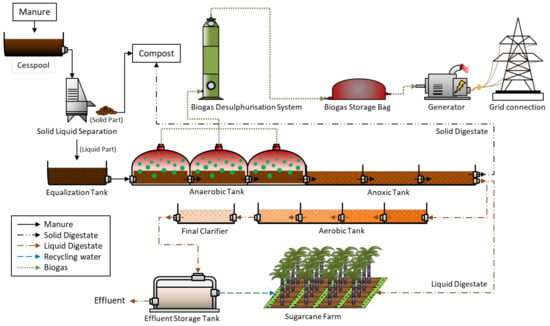
Figure 1.
Three-stage pig manure treatment system [34] combined with compost and bioenergy production.
This treatment method can effectively reduce COD and BOD, but the removal rates for TN and total phosphorus (TP) are only about 45% and 33%, respectively. Except to preserve the good parts of existing treatment as mentioned above, the purpose of this study was to recycle most of the wastewater discharged from the anoxic tank by coagulation and flocculation using NPAM. The aerobic reactor and the final clarifier tank were replaced by a flocculation tank and a neutralization tank (Figure 2). In addition, the precipitate of the flocculation tank was collected as a raw material for the organic fertilizer. Experimentally, the best pH value for the flocculation of NPAM was firstly adjusted by hydrochloric acid and sodium hydroxide and obtained based on its viscosity and morphology observation. Practically, we used calcium hydroxide for the pH adjuster followed by NPAM flocculation for treating the swine wastewater [35,36,37].
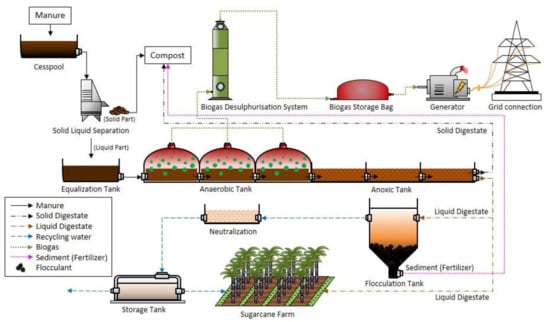
Figure 2.
Three-stage pig manure system was partially changed by replacing aerobic reactor and clarifier pool with flocculation tank and neutralization pool, respectively.
2. Materials and Methods
2.1. Experimental Design
Figure 2 shows the proposed processes for this study. In this scheme, the aerobic reactor was replaced by a flocculation tank because the flocculation was time-efficient and the flocculant could absorb compounds in the wastewater. The process clarifier was changed to a neutralization tank because the alkaline wastewater should be neutralized before further application or discharge. In addition, the sediment can be further used as a composting material.
The flocculant used in this study was NPAM. It was granular and had a molecular weight of 5 to 6 million g/mol (Acros Organics, Geel, Belgium). Hydrochloric acid and sodium hydroxide (Merck, Kenilworth, NJ, USA) were used to adjust the pH of the NPAM solution to 3.0 and 11.0, respectively. All chemicals were used directly without purification. The wastewater used for flocculation was swine wastewater that had been treated by solid separation and processed in an anoxic reactor (Figure 2) supplied by Taiwan Sugar Corporation. The water used to prepare the NPAM solution in these experiments was ultrapure water. In order to enhance the flocculation effect of NPAM, it was preferable to fully expand in the solution. The viscosity of the NPAM solution and the morphology of the NPAM on the glass surface were used to infer the state of its presence in the treated wastewater.
2.2. Preparation of NPAM Solution
A 0.5 wt% stock solution of NPAM was prepared and stored in a brown glass bottle in a dark place for further use. The NPAM (0.01 wt%) solution was prepared by diluting the stock solution for measuring viscosity of NPAM solution and observing the morphology of the NPAM folding state on a glass surface.
2.3. Viscosity Measurement and Morphology Observation of NPAM Treated Wastewater
The pH of the NPAM solution was adjusted to 3 and 11 with hydrochloric acid and sodium hydroxide solution (0.01 M). The viscosity of each NPAM solution was measured using a rotational viscometer (BROOKFIELD, MODEL 1 LVT, serial number 204617).
An NPAM film on a glass surface was prepared to observe its morphology. The glass substrate was washed with 75% ethanol, rinsed with a large amount of ultrapure water, then dried with a hair dryer. Subsequently, 5 μL of NPAM solution was dropped on the glass surface and dried at an environmental condition, with a temperature of 25 to 28 °C and a relative humidity of 50 to 60%. After the evaporation was completed, the residual solute formed a circular film on the glass substrate. The morphology of the PAM film was observed with an optical microscope (OM, light source F0-150H, SENTECH ADAPTER 1-6030) and an atomic force microscope (AFM, JPK, Axiovert 200). The AFM probe (Budget sensors Tap 150 AlG10) was established with a resonance frequency of 150 kHz and a force constant of 5 N/m and the tapping mode was adopted.
2.4. Wastewater Treatment and Analysis
The viscosity data and the morphology of the NPAM collected above were then used to further determine the feasible conditions for the flocculation process in the flocculation tank. The pH of the wastewater was adjusted to 11 or more with a calcium hydroxide slurry (Nippon Wako Pure Chemical Industries, Ltd., Osaka, Japan) on account of its greater safety in practical process than sodium hydroxide. The 0.5 wt% NPAM solution was gradually added to the wastewater and stirred. The suspended solids quickly flocculated and precipitated. Finally, the water quality of the wastewater before and after the treatment was analyzed by regular standard examination for comparison.
3. Results and Discussion
3.1. Effect of pH on Viscosity of NPAM
The conformation of the NPAM in the solution had a large effect on the viscosity of the solution. To understand the folding state of NPAM in solution, the viscosity of NPAM solutions at various pH conditions was analyzed and shown in Table 1. The viscosity of the NPAM (0.01 wt%) solution was measured at various pH values. The pH of the solution was adjusted using 0.01 N HCl and NaOH solutions. Sastry et al. [38] have explained the viscosity behavior and showed the extended form of conformations in the chains. Both the inter-unit repulsion and the presence of inter-unit attractions in the chain will affect the viscosity of the polymer solution.

Table 1.
The viscosity of the NPAM (0.01 wt%) solution in various pH values.
NPAM carries no net ions. However, due to internal hydrogen bonds between N-H and C=O in the PAM chain, the molecules in the solution will curl and so the viscosity of the solution is small. In an acid solution, the association of the proton in the amine groups induces a small net positive charge on PAM molecules as depicted in Equation (2). The internal hydrogen bond between N-H+ and C=O in the NPAM chain causes it to curl in solution.
[CH2-CHCONH2]n + xH+ →[CH2-CHCONH3+]x[CH2-CHCONH2]n−x
Kingsley Godwin Uranta et al. [39] have demonstrated that PAM will hydrolyze when mixed with an alkaline solution such as sodium hydroxide, and a portion of the amide group is converted to a carboxylate as shown in (3). The carboxylate group carries a negative charge and represents a reactive site, promoting ionic interaction. Therefore, at high pH conditions, NPAM molecules carry a net negative charge, which reduces internal hydrogen bonds, and the NPAM molecules in the solution expand due to electrostatic repulsion between the negative charge segments. The unfolded PAM chain is more crowded in solution, resulting in a higher viscosity.
[CH2-CHCONH2]n + yOH−→[CH2-CHCONH2]n−y[CH2-CHCOO−]y
3.2. Effect of pH on the Morphology of NPAM
The adsorption of polymers onto the solid surface is an important topic in industries. Many studies have discussed the adsorption mechanism of polymers on solid surfaces [40,41,42,43,44]. Besra et al. [42] found that the NPAM possesses a small residual anionicity due to the hydrolysis reaction. Lee and Somasundaran [45] have considered hydrogen bonding between PAM and the adsorbent, and showed that the most probable situation is one in which the electronegative C=O function of the amide acts as a hydrogen bonding base and the oxide surface hydroxyls as a H bonding acid.
In acid, not only the neutral undissociated SiOH group but also the positive SiOH2+ group can act as proton donors. The positive MOH2+ group should be more favorable than the neutral MOH to forming a hydrogen bond with the C=O group on the polymer. In this case, the adhesion of NPAM to the glass surface will be greater than under neutral conditions.
In the high pH solution, the negative SiO− on the surface of the glass cannot form a strong adsorption force with C=O or CO− produced by the hydrolysis of NPAM, and may only bond with the weakly acidic NH2 functional group to form a weak bond. A possible adsorption mechanism of NPAM on the glass surface under various pH conditions is depicted in Figure 3.

Figure 3.
Schematic diagram of PAM adsorption on a glass substrate.
It is well-known that a film flow will be generated within a liquid droplet on the solid surface, due to evaporation and convection, and the leading edge of the film flow is called a contact line [46,47,48]. The evaporation rate of the droplet surface is not uniform, and the thinnest portion of the contact line evaporates faster. For the NPAM solution, when the solvent was completely evaporated, an NPAM film was formed on the surface of the glass and its morphology was able to be observed with an OM and an AFM for further analysis.
Figure 4 shows the morphology of the NPAM film in acid. As described in the previous discussion, with internal hydrogen bonds between N-H+ and C=O in the NPAM chain, NPAM is curled in the solution, and could be adsorbed on the glass with a dot-like structure (AFM image). Due to the strong interaction between C=O and SiOH or SiOH2+, NPAM adheres to glass surface firmly. Such an NPAM molecule is hard to move with the film flow, and the distribution of NPAM is random as shown in the OM image (Figure 4a).
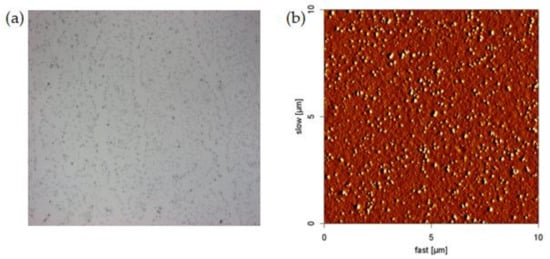
Figure 4.
Morphology of NPAM film in acid solution (pH = 3.0) (a) OM image (×1200); (b) AFM image.
In a neutral solution, the NPAM is curled like in an acidic solution and adsorbed on the surface of the glass in a spot shape (Figure 5b). However, since the interaction force between the NPAM and the glass surface is weaker than under acidic conditions, the NPAM moves with the film flow and forms a strip along the flow direction as shown in Figure 5a.
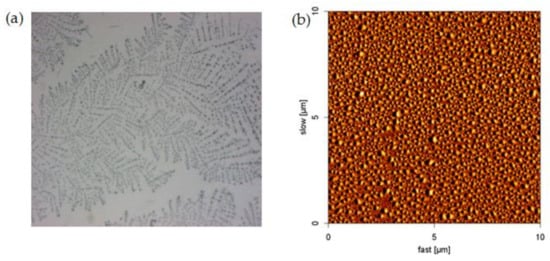
Figure 5.
Morphology of NPAM film (pH = 6.7); (a) OM image (×1200); (b) AFM image.
The alkali-treated NPAM solution is partially hydrolyzed to form a negatively charged carboxyl group, and the negative static charges in the molecule repel each other, resulting in the unfolding of the molecules in the solution with high viscosity. The adsorption force with the glass substrate is also weaker than the acid-treated or untreated NPAM.
The interaction force between the NPAM and the glass surface is small; even if the viscosity is relatively large and the membrane flows slowly, the solution can flow from the center outward to the contact line region. The PAM will expand outward from the center to form a rice spike as shown in Figure 6a,b.
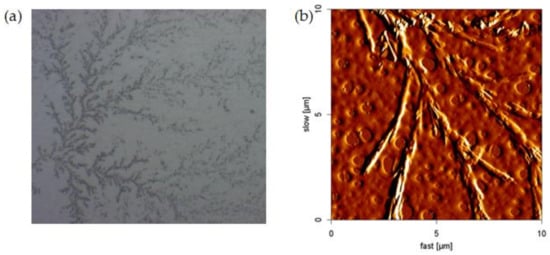
Figure 6.
Morphology of NPAM in alkalic solution (pH = 11.0); (a) OM image (×1200); (b) AFM image.
Based on the results discussed above, we propose a possible model of NPAM in solution and its adsorptive state on the glass surface, as shown in Figure 7. Obviously, NPAM in alkaline solution is a feasible condition for becoming a good flocculant.
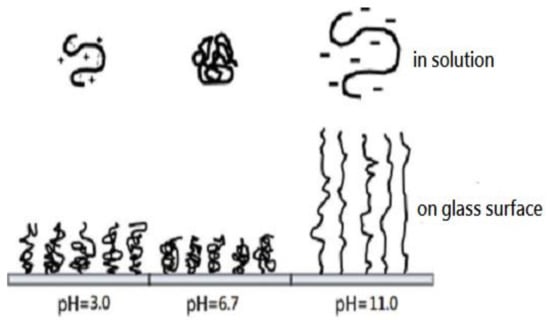
Figure 7.
Conformation of NPAM in solution and on glass substrate under different pH conditions.
3.3. Wastewater Treatment: Coagulation–Flocculation
Through the above experiments and discussions, we further adjusted the pH of the wastewater to 11 or more with a calcium hydroxide slurry to create the best condition for NPAM coagulation–flocculation in wastewater. After adjusting the pH, 1 mL of 0.1 wt% NPAM solution was gradually added to 1000 mL of wastewater and stirred at 20 cycles/s for 3 min. The suspended solids quickly flocculated and precipitated. Figure 8 showed the wastewater being coagulated and flocculated.
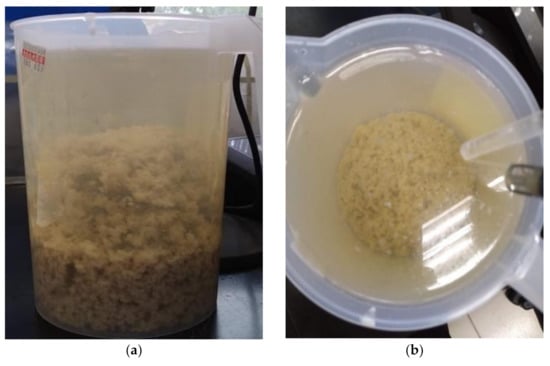
Figure 8.
Coagulation-flocculation process of wastewater by adding NPAM: (a) side view; (b) top view.
3.4. Wastewater Analysis before and after NPAM Coagulation–Flocculation
The swine wastewater was provided by the Taiwan Sugar Corporation. The water quality analysis adopted the standard analytical method provided by the Environmental Analysis Laboratory (EAL) of the Environmental Protection Agency (EPA), Taiwan Executive Yuan. The mass balance of the coagulation-flocculation process is depicted in Figure 9.
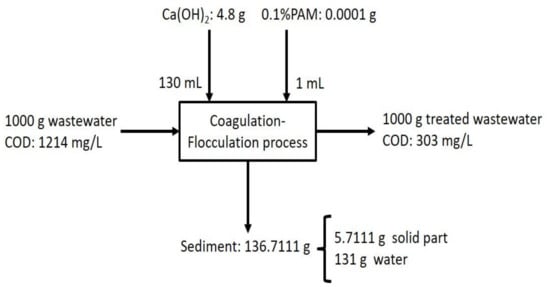
Figure 9.
Mass balance of coagulation-flocculation process.
In general, the characteristic compositions of swine wastewater are pH, COD, NH4+-N, TP, TN, and metallic ions, etc. In this study, Zn and Cu are included due to our long-term observation of these ions. The water quality is shown in Table 2. The removal rate was calculated from the difference between the initial and final concentrations of each component. The results showed that the removal rates of COD, copper ions, zinc ions, and TP were 75%, 96.3%, 97.8%, and 94.9%, respectively. The removal rate of nitrogen exceeds 99%. Obviously, heavy metals, TP, and nitrogen compounds can be effectively removed from the wastewater under proper adjustment of pH value and NPAM flocculation. Flocculation occurred rapidly (less than 10 min). The treated water was then filtered for recycling. This approach helps to reduce pig production costs and decrease the environmental impact. Additionally, due to the low concentration of heavy metals and most of the nitrogen and phosphorus compounds being precipitated in the sediment, and there being no adverse effect of NPAM on plant growth, the collected sediments can be used as raw materials for composting.

Table 2.
Water quality measured by standard analytical methods of the EAL.
As the pig industry consumes a lot of water resources, it is necessary to develop an effective and economical way to recycle wastewater to achieve sustainable development in the industry. Our study depicted in Figure 2 represents a possible process by replacing the aerobic reactor with a flocculating tank, by means of which large amounts of wastewater discharged from the anoxic reactor could be well treated and recycled. Along with the application of organic fertilizer production and power generation, this methodological application could provide an effective method for the sustainable development of the pig industry.
3.5. Economic Assessment
The results indicate that the residual flocculent can serve as an alternative source of nitrogen for plant nutrients. As in the case of sugarcane, according to the N fertilizer recommendation for sugarcane production from the Agriculture and Food Agency of the Council of Agriculture (COA), Taiwan Executive Yuan, sugarcane growth requires N fertilizer with 160–250 kg N ha−1 (depending on the irrigated condition), approximately equivalent to TWD 8000–TWD 12000 in terms of the cost of chemical fertilizer. Besides this, N fertilizer application is regarded as the key factor of N2O emissions. Considering its environmental sustainability, using residual flocculent to replace chemical fertilizer is worth developing.
4. Conclusions
This study proposed an effective method to recycle the swine wastewater dis-charged from the anoxic tank by adjusting the pH value and applying coagulation–flocculation of NPAM. In this treatment system, calcium hydroxide was selected as a pH adjuster for conducting coagulation. Non-ionic polyacrylamide (NPAM) was chosen as the flocculant because it has no inhibitory effect on the growth of plants, so the sediment in the flocculation tank can be used as a raw material for composting.
The best processing conditions for the coagulation–flocculation of NPAM in a flocculation tank were determined by the viscosity of the flocculant solution and its morphology on the glass surface. Experimental results showed that the removal rates of COD, copper ions, zinc ions, NH4+-N, TP, and TN are 75%, 96.3%, 97.8%, 99.1%, 94.9%, and 99.1%, respectively. It is believed that this coagulation–flocculation treating method, combining the existing production of organic fertilizers and biogas power generation for swine wastewater, could provide the sustainable development of the pig industry.
Author Contributions
Conceptualization, C.-C.C.; methodology, W.-C.L.; data curation, W.-C.L.; software, W.-C.L.; formal analysis, C.-C.C. and W.-C.L.; investigation, C.-C.C.; resources, C.-C.C.; writing—original draft preparation, W.-C.L.; writing—review and editing, C.-C.C. All authors have read and agreed to the published version of the manuscript.
Funding
This research received no external funding.
Institutional Review Board Statement
Not applicable.
Informed Consent Statement
Not applicable.
Acknowledgments
Authors appreciated the internal support from Animal Industry Business Division, Taiwan Sugar Corporation.
Conflicts of Interest
The authors declare no conflict of interest.
References
- Ikenganyia, E.; Onyeonagu, C.; Mbah, C.; Azuka, C.; Aneke, I. Evaluation of the agronomic potentials of swine waste as a soil amendment. Afr. J. Agric. Res. 2014, 9, 3761–3765. [Google Scholar]
- Zaleski, H.M.; Paquin, D.G. Composted Swine Manure for Vegetable Crop Application; CTAHR: Honolulu, HI, USA, 2005. [Google Scholar]
- Bilotta, P.; Steinmetz, R.L.R.; Kunz, A.; Mores, R. Swine effluent post-treatment by alkaline control and UV radiation combined for water reuse. J. Clean. Prod. 2017, 140, 1247–1254. [Google Scholar] [CrossRef]
- Cattaneo, M.; Finzi, A.; Guido, V.; Riva, E.; Provolo, G. Effect of ammonia stripping and use of additives on separation of solids, phosphorus, copper and zinc from liquid fractions of animal slurries. Sci. Total Environ. 2019, 672, 30–39. [Google Scholar] [CrossRef] [PubMed]
- Fongaro, G.; Viancelli, A.; Magri, M.; Elmahdy, E.; Biesus, L.; Kich, J.; Kunz, A.; Barardi, C. Utility of specific biomarkers to assess safety of swine manure for biofertilizing purposes. Sci. Total Environ. 2014, 479, 277–283. [Google Scholar] [CrossRef] [PubMed]
- Cahoon, L.B.; Halkides, C.J.; Song, B.; Williams, C.M.; Dubay, G.R.; Fries, A.; Farmer, J.; Fridrich, W.; Brookshire, C. Swine waste as a source of natural products: A carotenoid antioxidant. Agric. Sci. 2012, 3, 806. [Google Scholar] [CrossRef]
- Leite, S.; Leite, B.; Isola, A.; Freitas, L.; Souza, J. Application of Cleaner Production Methodology to Evaluate the Generation of Bioenergy in a Small Swine Farm. Chem. Eng. Trans. 2014, 39, 589–594. [Google Scholar]
- Shih, M.F.; Lay, C.H.; Lin, C.Y.; Chang, S.H. Exploring the environmental and economic potential for biogas production from swine manure wastewater by life cycle assessment. Clean Technol. Environ. Policy 2021. [Google Scholar] [CrossRef]
- Lin, C.Y.; Chai, W.S.; Lay, C.H.; Chen, C.C.; Lee, C.Y.; Show, P.L. Optimization of hydrolysis-acidogenesis phase of swine manure for biogas production using two-stage anaerobic fermentation. Processes 2021, 9, 1324. [Google Scholar] [CrossRef]
- Sandoval-Herazo, M.; Martínez-Reséndiz, G.; Fernández Echeverria, E.; Fernández-Lambert, G.; Sandoval Herazo, L.C. Plant biomass production in constructed wetlands treating swine wastewater in tropical climates. Fermentation 2021, 9, 296. [Google Scholar] [CrossRef]
- Muamar, A.; Tijane, M.; Shawqi, E.; El Housni, A.; Zouahri, A.; Bouksaim, M. Assessment of the impact of wastewater use on soil properties. J. Mater. Environ. Sci. 2014, 5, 961–966. [Google Scholar]
- Lenghan-Sauriol, M.-È.; Leduc, S.; Raghavan, G. An Integrated System Approach for Swine Manure Management at the Farm Level; Unpublished Work; McGill University: Montréal, QC, Canada, 2009; Available online: https://escholarship.mcgill.ca/concern/reports/6w924b947?locale=en (accessed on 28 September 2021).
- Morris, T.F.; Murrell, T.S.; Beegle, D.B.; Camberato, J.J.; Ferguson, R.B.; Grove, J.; Ketterings, Q.; Kyveryga, P.M.; Laboski, C.A.; McGrath, J.M. Strengths and limitations of nitrogen rate recommendations for corn and opportunities for improvement. Agron. J. 2018, 110, 1–37. [Google Scholar] [CrossRef]
- Malakar, A.; Snow, D.D.; Ray, C. Irrigation Water Quality—A Contemporary Perspective. Water 2019, 11, 1482. [Google Scholar] [CrossRef]
- Vanotti, M.B.; Ariel Szogi, A.A.; Hunt, P.G.; Millner, P.D.; Humenik, F.J. Development of environmentally superior treatment system to replace anaerobic swine lagoons in the USA. Bioresour. Technol. 2007, 98, 3184–3194. [Google Scholar] [CrossRef] [PubMed]
- Cheng, J.; Liu, B. Swine wastewater treatment in anaerobic digesters with floating medium. Trans. ASAE 2002, 45, 799–805. [Google Scholar] [CrossRef][Green Version]
- Makara, A.; Kowalski, Z. Pig manure treatment and purification by filtration. J. Environ. Manag. 2015, 161, 317–324. [Google Scholar] [CrossRef]
- Viancelli, A.; Kunz, A.; Steinmetz, R.; Kich, J.; Souza, C.; Canal, C.; Coldebella, A.; Esteves, P.; Barardi, C. Performance of two swine manure treatment systems on chemical composition and on the reduction of pathogens. Chemosphere 2013, 90, 1539–1544. [Google Scholar] [CrossRef]
- Dosta, J.; Rovira, J.; Galí, A.; Macé, S.; Mata-Alvarez, J. Integration of a Coagulation/Flocculation step in a biological sequencing batch reactor for COD and nitrogen removal of supernatant of anaerobically digested piggery wastewater. Bioresour. Technol. 2008, 99, 5722–5730. [Google Scholar] [CrossRef]
- De Godos, I.; Guzman, H.O.; Soto, R.; García-Encina, P.A.; Becares, E.; Muñoz, R.; Vargas, V.A. Coagulation/flocculation-based removal of algal–bacterial biomass from piggery wastewater treatment. Bioresour. Technol. 2011, 102, 923–927. [Google Scholar] [CrossRef]
- Garcia, M.; Vanotti, M.; Szogi, A. Simultaneous separation of phosphorus sludge and manure solids with polymers. Trans. ASABE 2007, 50, 2205–2215. [Google Scholar] [CrossRef]
- Vanotti, M.; Szogi, A.; Hunt, P.; Ellison, A.; Millner, P.; Humenik, F. Development of an environmentally superior treatment system for replacing anaerobic swine waste lagoons. Proc. Water Environ. Fed. 2005, 2005, 4073–4092. [Google Scholar] [CrossRef][Green Version]
- Vanotti, M.; Rice, J.; Ellison, A.; Hunt, P.; Humenik, F.; Baird, C. Solid-liquid separation of swine manure with polymer treatment and sand filtration. Trans. ASAE 2005, 48, 1567–1574. [Google Scholar] [CrossRef]
- Haveroen, M.E.; MacKinnon, M.D.; Fedorak, P.M. Polyacrylamide added as a nitrogen source stimulates methanogenesis in consortia from various wastewaters. Water Res. 2005, 39, 3333–3341. [Google Scholar] [CrossRef] [PubMed]
- Wen, Q.; Chen, Z.; Zhao, Y.; Zhang, H.; Feng, Y. Biodegradation of polyacrylamide by bacteria isolated from activated sludge and oil-contaminated soil. J. Hazard. Mater. 2010, 175, 955–959. [Google Scholar] [CrossRef] [PubMed]
- Sang, G.; Pi, Y.; Bao, M.; Li, Y.; Lu, J. Biodegradation for hydrolyzed polyacrylamide in the anaerobic baffled reactor combined aeration tank. Ecol. Eng. 2015, 84, 121–127. [Google Scholar] [CrossRef]
- Zhao, L.; Bao, M.; Yan, M.; Lu, J. Kinetics and thermodynamics of biodegradation of hydrolyzed polyacrylamide under anaerobic and aerobic conditions. Bioresour. Technol. 2016, 216, 95–104. [Google Scholar] [CrossRef]
- Xiong, B.; Loss, R.D.; Shields, D.; Pawlik, T.; Hochreiter, R.; Zydney, A.L.; Kumar, M. Polyacrylamide degradation and its implications in environmental systems. NPJ Clean Water 2018, 1, 17. [Google Scholar] [CrossRef]
- Smith, E.A.; Prues, S.L.; Oehme, F.W. Environmental degradation of polyacrylamides. Ecotoxicol. Environ. Saf. 1997, 37, 76–91. [Google Scholar] [CrossRef] [PubMed]
- Caulfield, M.J.; Hao, X.; Qiao, G.G.; Solomon, D.H. Degradation on polyacrylamides. Part I. Linear polyacrylamide. Polymer 2003, 44, 1331–1337. [Google Scholar] [CrossRef]
- Caulfield, M.J.; Hao, X.; Qiao, G.G.; Solomon, D.H. Degradation on polyacrylamides. Part II. Polyacrylamide gels. Polymer 2003, 44, 3817–3826. [Google Scholar] [CrossRef]
- Holliman, P.J.; Clark, J.A.; Williamson, J.C.; Jones, D.L. Model and field studies of the degradation of cross-linked polyacrylamide gels used during the revegetation of slate waste. Sci. Total Environ. 2005, 336, 13–24. [Google Scholar] [CrossRef]
- Kuboi, T.; Fujii, K. Toxicity of cationic polymer flocculants to higher plants: I. Seedling assay. Soil Sci. Plant Nutr. 1984, 30, 311–320. [Google Scholar] [CrossRef]
- Chou, L.H.; Tsai, R.I.; Chang, J.R.; Lee, M.T. Regenerable adsorbent for removing ammonia evolved from anaerobic reaction of animal urine. J. Environ. Sci. 2006, 18, 1176–1181. [Google Scholar] [CrossRef]
- Entry, J.A.; Sojka, R. The efficacy of polyacrylamide and related compounds to remove microorganisms and nutrients from animal wastewater. J. Environ. Qual. 2000, 29, 1905–1914. [Google Scholar] [CrossRef]
- Entry, J.A.; Sojka, R.; Watwood, M.; Ross, C. Polyacrylamide preparations for protection of water quality threatened by agricultural runoff contaminants. Environ. Pollut. 2002, 120, 191–200. [Google Scholar] [CrossRef]
- Gorham, J.M.; Wnuk, J.D.; Shin, M.; Fairbrother, H. Adsorption of natural organic matter onto carbonaceous surfaces: Atomic force microscopy study. Environ. Sci. Technol. 2007, 41, 1238–1244. [Google Scholar] [CrossRef]
- Sastry, N.; Dave, P.; Valand, M. Dilute solution behaviour of polyacrylamides in aqueous media. Eur. Polym. J. 1999, 35, 517–525. [Google Scholar] [CrossRef]
- Uranta, K.G.; Gomari, S.R.; Russell, P.; Hamad, F. Determining safe maximum temperature point (SMTP) for polyacrylamide polymer (PAM) in saline solutions. J. Oil Gas Petrochem. Sci. 2018, 1, 1–8. [Google Scholar] [CrossRef]
- Kramer, G.; Somasundaran, P. Conformational behavior of polyelectrolyte complexes at the solid/liquid interface. Langmuir 2002, 18, 9357–9361. [Google Scholar] [CrossRef]
- Yu, X.; Somasundaran, P. Kinetics of polymer conformational changes and its role in flocculation. J. Colloid Interface Sci. 1996, 178, 770–774. [Google Scholar] [CrossRef]
- Besra, L.; Sengupta, D.; Roy, S.; Ay, P. Influence of polymer adsorption and conformation on flocculation and dewatering of kaolin suspension. Sep. Purif. Technol. 2004, 37, 231–246. [Google Scholar] [CrossRef]
- Kamiyama, Y.; Israelachvili, J. Effect of pH and salt on the adsorption and interactions of an amphoteric polyelectrolyte. Macromolecules 1992, 25, 5081–5088. [Google Scholar] [CrossRef]
- Song, X.; Cao, M.; Han, Y.; Wang, Y.; Kwak, J.C. Adsorption of hydrophobically modified poly (acrylamide)-co-(acrylic acid) on an amino-functionalized surface and its response to the external solvent environment. Langmuir 2007, 23, 4279–4285. [Google Scholar] [CrossRef] [PubMed]
- Lee, L.-T.; Somasundaran, P. Adsorption of polyacrylamide on oxide minerals. Langmuir 1989, 5, 854–860. [Google Scholar] [CrossRef]
- Deegan, R.D.; Bakajin, O.; Dupont, T.F.; Huber, G.; Nagel, S.R.; Witten, T.A. Capillary flow as the cause of ring stains from dried liquid drops. Nature 1997, 389, 827–829. [Google Scholar] [CrossRef]
- Doumenc, F.; Guerrier, B. Drying of a solution in a meniscus: A model coupling the liquid and the gas phases. Langmuir 2010, 26, 13959–13967. [Google Scholar] [CrossRef]
- Kaya, D.; Belyi, V.; Muthukumar, M. Pattern formation in drying droplets of polyelectrolyte and salt. J. Chem. Phys. 2010, 133, 114905. [Google Scholar] [CrossRef]
Publisher’s Note: MDPI stays neutral with regard to jurisdictional claims in published maps and institutional affiliations. |
© 2022 by the authors. Licensee MDPI, Basel, Switzerland. This article is an open access article distributed under the terms and conditions of the Creative Commons Attribution (CC BY) license (https://creativecommons.org/licenses/by/4.0/).